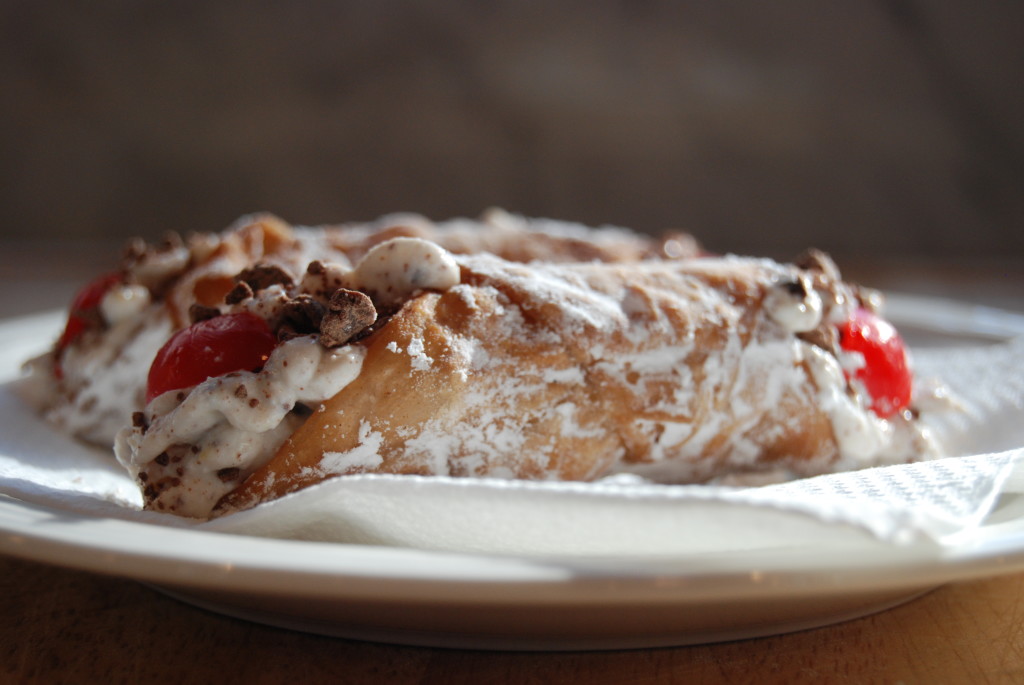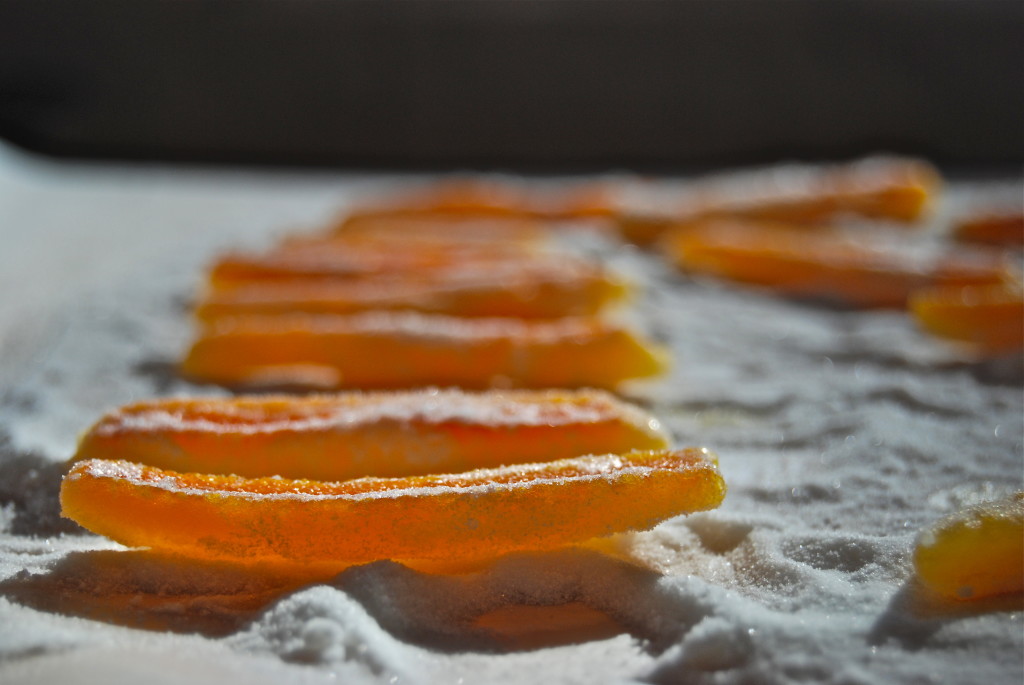Cannoli siciliani
It all started when a friend jokingly asked, “Come on…when are you going to make us some authentic cannoli?”
The conversation that followed revealed that years ago, this friend earned the affection of the woman who is now his wife by traversing New York City with her in search of the best cannolo. The challenge was on. Could we make cannoli that would take him back in time to that day in Manhattan?
The first step was to find good-quality ricotta. We prefer the more flavorful sheep’s milk ricotta, but a good quality cow’s milk ricotta will work, too. A trip to an Italian deli or specialty grocer to find fresh ricotta is a must – the plastic tubs of ricotta you find in the supermarket do not pass muster.
The next decision was whether to buy cannoli shells or make our own. Perfectly good pre-made cannoli shells are readily available, but just for fun we reviewed recipes in our collection of Italian cookbooks and decided to give a try to making our own. We would need cannoli forms, which we found. The final challenge was finding candied orange peel for the filling. Here in Minneapolis, it is usually available only during the holiday fruit-cake season. Undeterred, we decided that if we could make our own cannoli shells, we could certainly make our own candied orange peel!
We got to work on a Sunday morning, Stefano rolling out the dough and cutting it into squares while I wrapped the dough around the cannoli forms and fried the shells to perfection – or at least tried to. At first, the dough was too thick, and the shells came out gummy. Stefano rolled the dough thinner and thinner until they were perfect. Taking only a few seconds to cook in the hot oil, they came out light and crisp.
While the shells cooled, we got to work making the candied orange peel and the filling. There is no better flavor combination than sweet, creamy ricotta with a hint of orange citrus. Except maybe a bit of dark chocolate along with it.
When all was done, we had two dozen of the most delicious cannoli that, in our opinion, would stand up to any New York City bakery. Stefano commented that he must have married a Sicilian.

Cannoli Siciliani
These ricotta-filled Sicilian treats are one of Italy's iconic desserts. You can buy cannoli shells, or try your hand at making them yourself.
Ingredients
For the cannoli shells
- 100 grams flour
- 100 grams butter
- 100 grams sugar
- 1/4 tsp semisweet cocoa powder
- 1 shot of Marsala
- 2 eggs, beaten
- peanut oil for frying
- powdered sugar for dusting
For the candied orange peel
- 2 oranges
- sugar
- water
For the filling
- 250 grams whole milk ricotta
- 150 grams sugar
- 1 Tbsp pure orange extract
- 2 Tbsp candied orange peel
- 75 grams grated dark chocolate
Garnish
- 2 Tbsp ground pistachio
- Maraschino cherries
Instructions
Prepare the Cannoli Shells
- Mix together the flour, butter, sugar, cocoa and Marsala until it forms a smooth dough. Cover and refrigerate for at least 2 hours.
- Pour the peanut oil into a medium-sized saucepan, ensuring that the oil is about 10 cm or 4 inches deep, and heat the oil until sizzling, but do not let it reach a smoking point.
- On a well floured work surface, roll out pieces of dough into long, rectangular strip about 2 mm or 1/16 inch thick.
- Cut the dough into squares. The diagonal of each square should be equal to the length of the cannolo form.
- Wrap a square of dough diagonally around the cannolo form, so that two corners of dough meet at the top in the center of the form. Dip your finger in the beaten egg and seal the two corners together.
- Using a set of kitchen prongs, carefully set the cannolo shell into the hot oil, turn quickly, and once it achieves a medium brown color remove it to a paper-towel coated drying rack once it.
- Repeat for the remainder of the dough.
- Once the shells are cool, roll them in a shallow plate full of powdered sugar, and tap the excess off. Set aside to be filled.
Make Candied Orange Peel
- Remove the peel from two oranges and cut it into thin slices.
- Place the peel in a saucepan and cover with water. Bring the water to a boil and let boil for two minutes. Leave the orange peel in the water and allow it all to cool.
- Toss out the water, and repeat this process two more times in order to draw the bitter flavors out of the peel.
- Remove the orange peel and weigh it. Add the same amount of water and the same amount of sugar to the saucepan. For example, if your orange peel weighs 100 grams, then add 100 grams of water and 100 grams of sugar to the pan, leaving the orange peel set aside.
- Cook the sugar and water over medium heat until the sugar has dissolved and it becomes a sugar syrup.
- Add the orange peel and allow it to cook at a low boil until the syrup cooks away. Be careful to not allow it to caramelize.
- Dust a piece wax paper with an abundant amount of sugar (superfine baking sugar works very nicely) and place the candied orange peel on top to cool.
Make the Filling and Prepare the Cannoli
- In a large bowl, use a wooden spoon to mix the ricotta, sugar, dark chocolate, candied orange peel, and orange extract.
- Using a pastry bag and a tip with a wide opening, fill the cannoli. Pipe filling into each shell from the middle out one side, and then turn the shell and fill from the middle out the other side.
- Dip each end of the cannoli in shaved or ground dark chocolate and poke in a small piece of maraschino cherry.
Notes
We prepared four cannolo shells at a time and fried two shells at once, which worked well. It only took a few seconds for them to cook. Be careful to drain the hot oil out of the center of the cannolo form as you remove it from the oil. Use paper towels to quickly slide the fried shells off of the forms.
Your cannoli shells will absorb moisture from the ricotta, so they are best eaten as soon after filling as possible. Alternatively, do as the Sicilians do – fill your shells a few at a time as you plan to serve them.




Lisa
Those look so delicious, Cara! I’ve never made my own, but as a teenager worked in an Italian bakery in NYC that many people thought made the best cannoli–always filled at time of ordering, no soggy shells! So, I’d be curious to hear where your colleague and his wife made the rounds! You have inspired me to try. My husband makes ricotta and candied orange peel, so really, I don’t have many excuses!
duespaghetti
I will ask about the bakery, Lisa. I hope you do try – let us know how they turn out!
lapiubelladitutte
For someone who has tried and not veru much liked cannoli, yours makes me think twice!!!
duespaghetti
Thanks for stopping by! We were surprisingly pleased with how they turned out.
lapiubelladitutte
You are welcome, I am suprisingly pleased with how good they look!!!:-))))
Simona
Great job, Cara! It is also my experience that candied peel is hard to come by and it becomes a bit easier during the Holidays. Making cannoli is a labor of love: every once in a while, it’s fun to do it.
duespaghetti
Thank you, Simona. I agree that cannoli will be an “every once in a while” endeavor!
Frank Fariello
I am ever so impressed by the talent it takes to make these! They look fabulously good…
duespaghetti
It really just came down to figuring out how thin to roll the dough. Once we figured that out, it actually was quite simple.
PolaM
Great job! I also run into the orange peel issue last year… Maybe we should stock up during Christmas season!
Caroline
Grew up in New Orleans and ate Angelo Brocato’s cannoli . I started making mine when we moved away in the early 70’s. They are a treat indeed ! They don’t put orange peel in them though. Only a dusting of ground pistachios on the ends or you can get the ones with tiny chocolate chunks in the filling. When I remodeled my kitchen 6 yrs ago I added a built in deep fat fryer by Miele just so I could fry with ease. Great post !